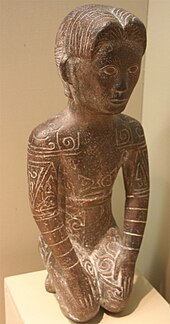Yue (state)
This article needs additional citations for verification. (September 2010) |
State of Yue 越 | |||||||||
|---|---|---|---|---|---|---|---|---|---|
| ?–306 BC | |||||||||
Wu | |||||||||
| Government | Monarchy | ||||||||
| King | |||||||||
• 496–465 BC | Goujian | ||||||||
| Historical era | Spring and Autumn period Warring States period | ||||||||
• Established | ? | ||||||||
• Conquered by Chu | 306 BC | ||||||||
| |||||||||
| Yue | ||
|---|---|---|
Tâi-lô Ua̍t | | |
| Old Chinese | ||
| Baxter (1992) | *wjat | |
| Baxter–Sagart (2014) | *[ɢ]ʷat | |
Yue (
in 306 BC.History

A specific kingdom, which had been known as the "Yue Guo" (越國) in modern

With help from Wu's enemy Chu, Yue won after several decades of conflict. The famous Yue King Goujian destroyed and annexed Wu in 473 BC. During the reign of Wuqiang (無彊), six generations after Goujian, Yue was partitioned by Chu and Qi in 306 BC.
During its existence, Yue was famous for the quality of its metalworking, particularly its swords. Examples include the extremely well-preserved Swords of Goujian and Zhougou.
The Yue state appears to have been a largely indigenous political development in the lower Yangtze. This region corresponds with that of the old corded-ware Neolithic, and it continued to be one that shared a number of practices, such as tooth extraction, pile building, and cliff burial. Austronesian speakers also still lived in the region down to its conquest and sinification beginning about 240 BC.[1]
What set the Yue apart from other Sinitic states of the time was their possession of a navy.[2] Yue culture was distinct in its practice of naming boats and swords.[3] A Chinese text described the Yue as a people who used boats as their carriages and oars as their horses.[4]
Rulers of Yue family tree
Their
| Rulers of Yue family tree | ||||||||||||||||||||||||||||||||||||||||||||||||||||||||||||||||||||||||||||||||||||||||||||||||||||||||||||||||||||||||||||||||||||||||||
|---|---|---|---|---|---|---|---|---|---|---|---|---|---|---|---|---|---|---|---|---|---|---|---|---|---|---|---|---|---|---|---|---|---|---|---|---|---|---|---|---|---|---|---|---|---|---|---|---|---|---|---|---|---|---|---|---|---|---|---|---|---|---|---|---|---|---|---|---|---|---|---|---|---|---|---|---|---|---|---|---|---|---|---|---|---|---|---|---|---|---|---|---|---|---|---|---|---|---|---|---|---|---|---|---|---|---|---|---|---|---|---|---|---|---|---|---|---|---|---|---|---|---|---|---|---|---|---|---|---|---|---|---|---|---|---|---|---|---|
| ||||||||||||||||||||||||||||||||||||||||||||||||||||||||||||||||||||||||||||||||||||||||||||||||||||||||||||||||||||||||||||||||||||||||||
Aftermath

After the fall of Yue, the ruling family moved south to what is now northern Fujian and set up the Minyue kingdom. This successor state lasted until around 150 BC, when it miscalculated an alliance with the Han dynasty.
Mingdi, Wujiang's second son, was appointed minister of Wucheng (present-day
When the religious leader Xu Chang launched a rebellion against the Han dynasty in 172 CE, he declared the state of Yue restored and appointed his father Xu Sheng as "King of Yue". The rebels were crushed in 174.[7]
Astronomy
In Chinese astronomy, there are two stars named for Yue:
- Yue (along with Wu) is represented by the star Zeta Aquilae in the "Left Wall" of the Heavenly Market enclosure[8][9]
- Yue is also represented by the star
Biology
The
People from Yue
- Yuenü, swordswoman & author of the earliest-known exposition on swordplay[13]
- Xi Shi, a famous beauty of the ancient Yue Guo.
Language
Possible languages spoken in the state of Yue may have been of
See also
- Tai languages
- Tai-Kadai languages
- Austronesian languages
- Austro-Tai languages
- Tai peoples
- Austronesian peoples
- Austro-Tai peoples
- Baiyue
- Minyue
- Wu (state)
- Dong'ou Kingdom
- Âu Việt
- Lạc Việt
References
- ISBN 9780871698650.
- ^ Holm 2014, p. 35.
- ^ Kiernan 2017, pp. 49–50.
- ^ Kiernan 2017, p. 50.
- Wu–Yue Chunqiu. 《越王無余外傳》["Yuèwàng Wúyú Wàizhuàn"]. Accessed 5 December 2013.(in Chinese)
- ^ Theobald, Ulrich. China Knowledge. "Chinese History – Yue 越 (Zhou period feudal state)". 2000. Accessed 5 December 2013.
- ^ de Crespigny (2016), pp. 402–403.
- ^ "AEEA (Activities of Exhibition and Education in Astronomy) 天文教育資訊網". 23 Jul 2006. (in Chinese)
- ^ Allen, Richard. "Star Names – Their Lore and Meaning: Aquila".
- ^ "Star Tales – Capricornus". www.ianridpath.com. Retrieved 30 July 2019.
- ^ Allen, Richard. "Star Names – Their Lore and Meaning: Capricornus".
- ^ Wolf, Yuri; Krupovic, Mart; Zhang, Yong Zhen; Maes, Piet; Dolja, Valerian; Koonin, Eugene V.; Kuhn, Jens H. "Megataxonomy of negative-sense RNA viruses" (docx). International Committee on Taxonomy of Viruses (ICTV). Retrieved 12 January 2019.[dead link]
- ^ Lily Xiao Hong Lee; A. D. Stefanowska (2007). Biographical dictionary of Chinese women: antiquity through Sui, 1600 B.C.E.-618 C.E. M.E. Sharpe. p. 91.
- ^ a b Li 2001, p. 15.
Sources
- ISBN 9789004324916.
- Holm, David (2014). "A Layer of Old Chinese Readings in the Traditional Zhuang Script". Bulletin of the Museum of Far Eastern Antiquities: 1–45.
- Kiernan, Ben (2017), Việt Nam: A History from Earliest Times to the Present, Oxford University Press, ISBN 978-0-195-16076-5.
- Li, Hui (2001). "Daic Background Vocabulary in Shanghai Maqiao Dialect" (PDF). Proceedings for Conference of Minority Cultures in Hainan and Taiwan, Haikou: Research Society for Chinese National History: 15–26. Archived from the original (PDF) on 2018-03-27. Retrieved 2018-03-28.
Further reading
- Zhengzhang Shangfang 1999. "An Interpretation of the Old Yue Language Written in Goujiàn's Wéijiă lìng" [句践"维甲"令中之古越语的解读]. In Minzu Yuwen 4, pp. 1–14.
- Zhengzhang Shangfang 1998. "Gu Yueyu" 古越語 [The old Yue language]. In Dong Chuping 董楚平 et al. Wu Yue wenhua zhi 吳越文化誌 [Record of the cultures of Wu and Yue]. Shanghai: Shanghai renmin chubanshe, 1998, vol. 1, pp. 253–281.
- Zhengzhang Shangfang 1990. "Some Kam-Tai Words in Place Names of the Ancient Wu and Yue States" [古吴越地名中的侗台语成份]. In Minzu Yuwen 6.
External links
- Eric Henry: The Submerged History of Yuè (Sino-Platonic Papers 176, May 2007)
